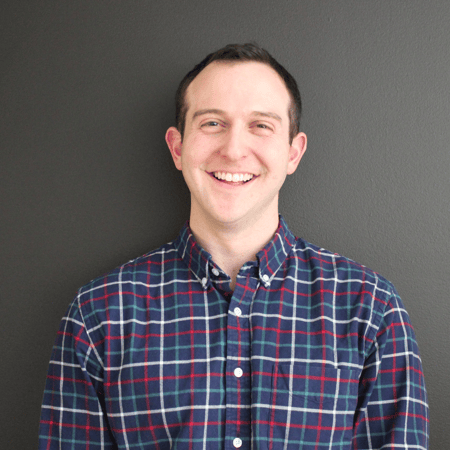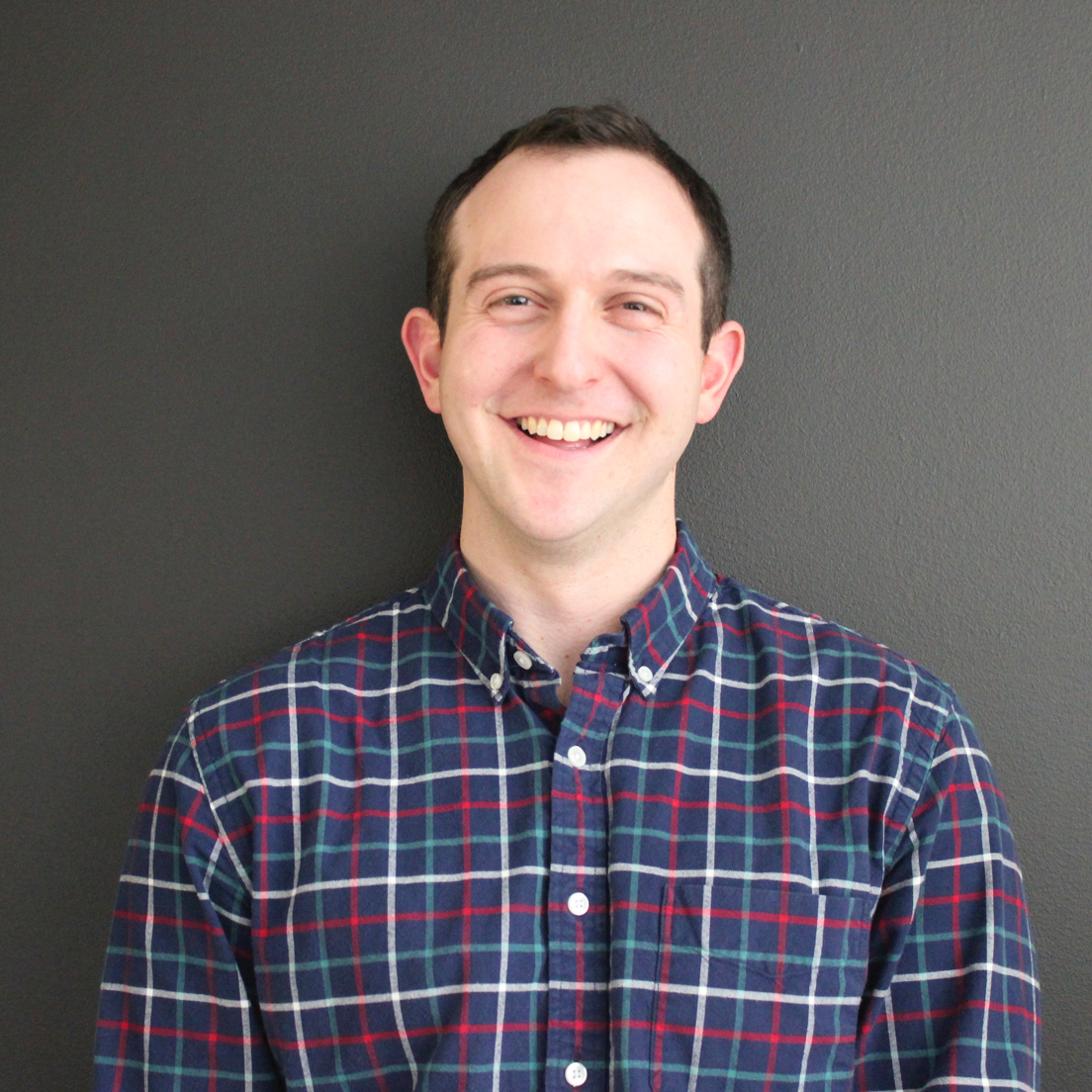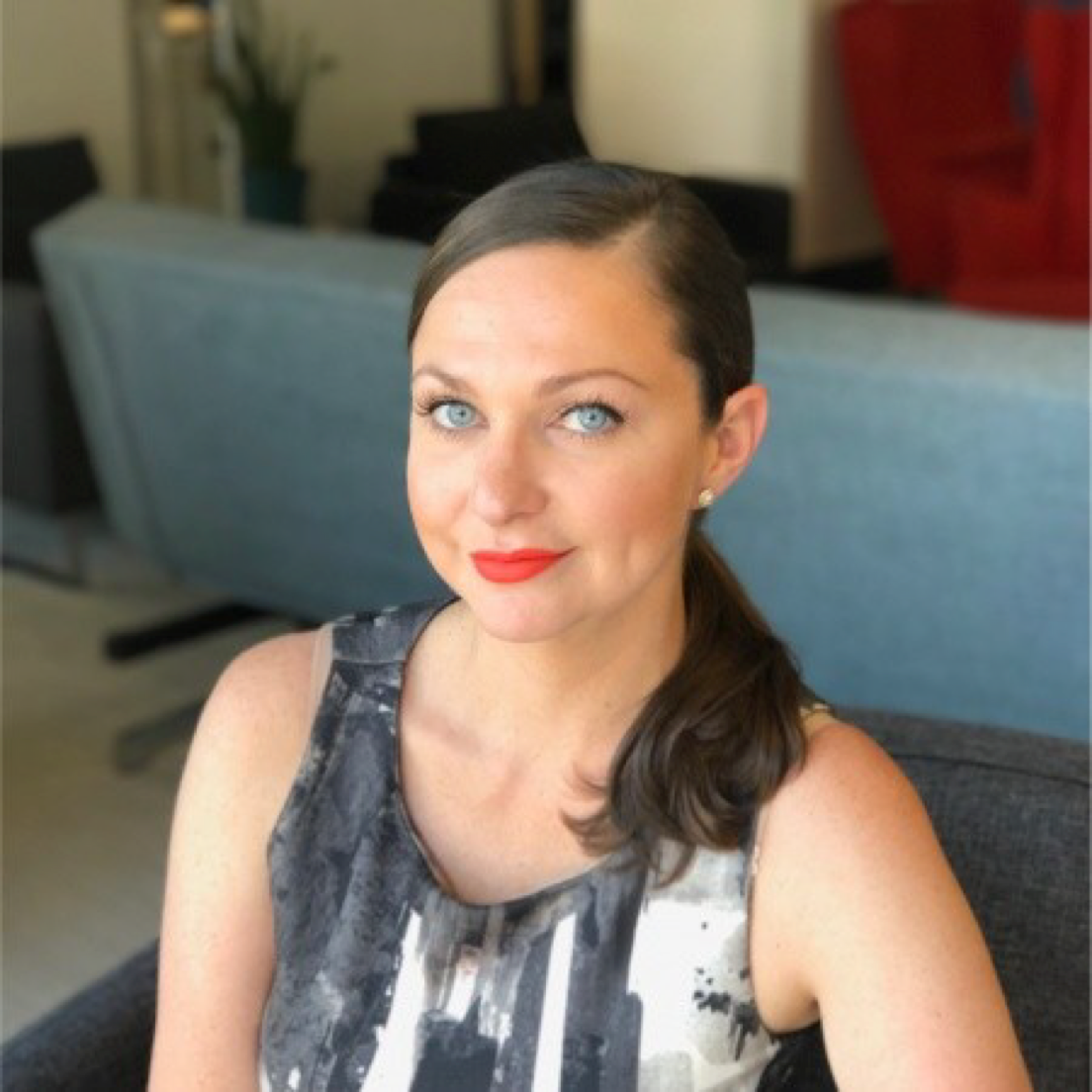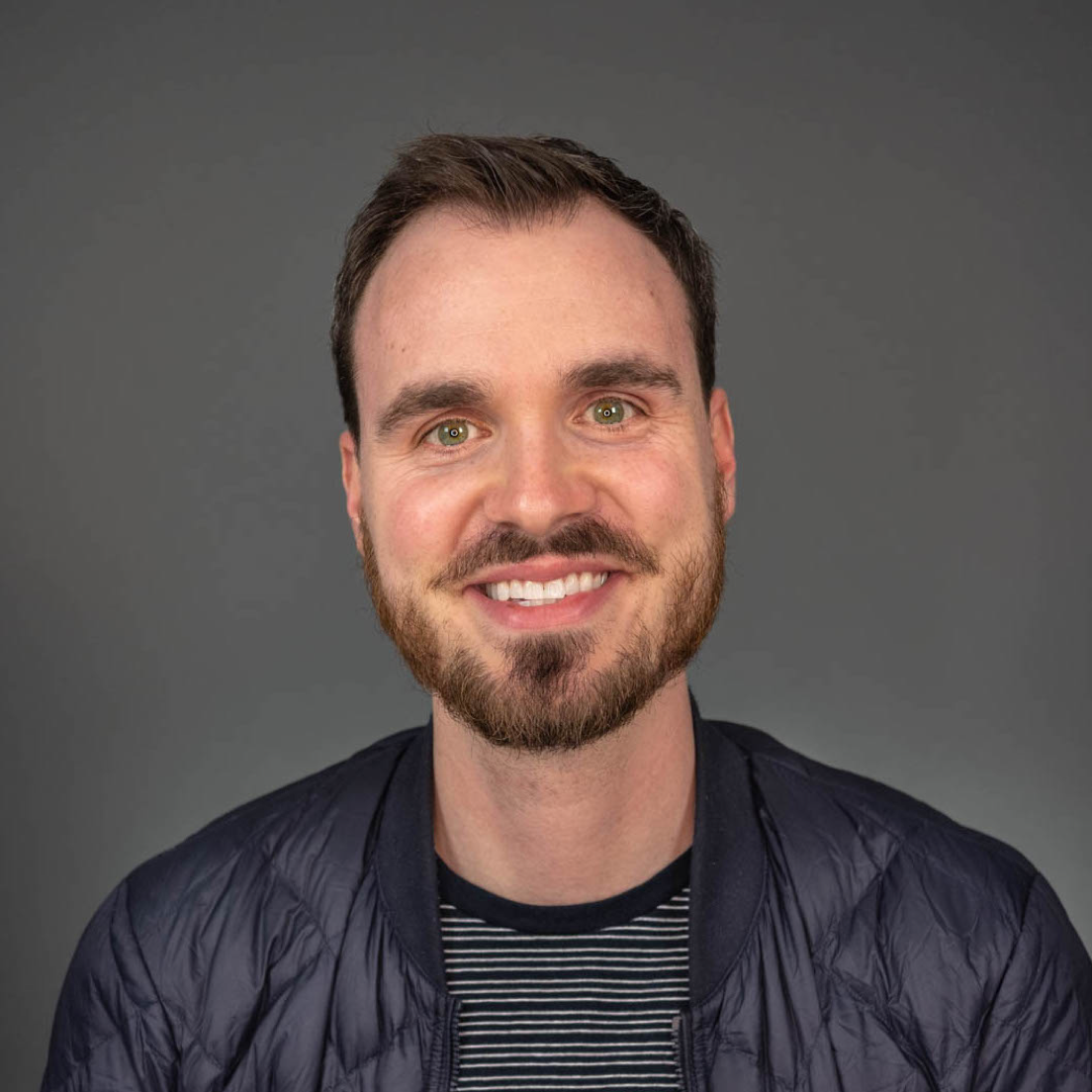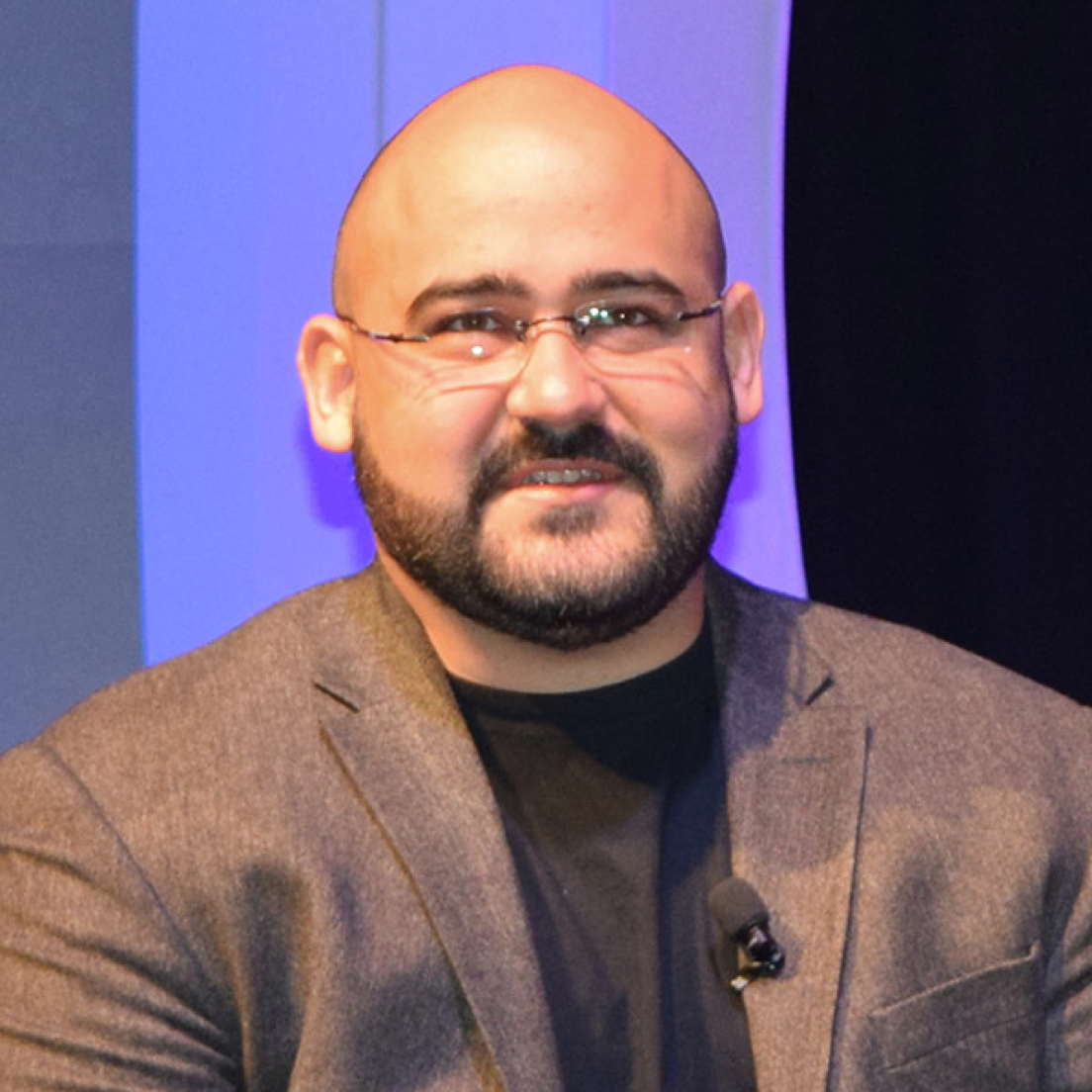About the episode
What would you do if you had 7,000 rivals competing for your audience’s attention and budget? Dave Gerhardt, Drift’s VP of marketing, focused on building a magnetic brand—and it worked.
Dave joined host Matthew Kammerer to dig into the importance of branding as a foundation for marketing growth, how Drift approaches brand on different platforms, and why best practices are actually holding you back.
You can connect with Dave on Twitter and LinkedIn.
Don’t have 30 minutes to spare? Jump ahead to key sections outlined below, or keep scrolling for a full transcript of the episode.
- [00:48] How do you build awareness for a product that people don’t instantly understand?
- [03:38] How do you communicate brand throughout marketing?
- [08:30] What’s your paid marketing strategy?
- [10:15] How do you align traditional and nontraditional marketing channels?
- [14:08] Why do so many marketers settle for usual, traditional strategies?
- [15:50] How do you advocate a bolder marketing strategy to an unsupportive boss?
- [17:50] How do you plan your drip email marketing campaigns?
- [22:12] What’s your strategy with events at Drift?
- [25:41] What advice would you give yourself three years ago?
- [28:50] What was the biggest learning moment from your career?
"You don't need to hire a six figure agency or team of creatives. You can create your brand yourself."
Episode is brought to you by
-

Matthew Kammerer
Show Host -

Vanessa King
Producer -

Joshua Schnell
Producer
Show Transcript
Matthew Kammerer: So, at Drift you’ve had to create market share for a category that a lot of businesses didn’t know they needed. How do you build awareness for a product that people don’t instantly understand?
Dave Gerhardt: To me, everything starts with somebody’s mind. So, for us it was all about branding, storytelling, copywriting. We couldn’t just go talk about the problem that Drift solves without really setting up the story. I actually think we haven’t done a great job on the other side of it, which is the product marketing and the how-to piece yet. We have done a good job of telling the story.
For us, it started with finding this cause. We started this whole movement around no forms. So that was a really changing moment for us because we gave people a cause bigger than Drift to rally around, and that helped bring awareness for the problem that we were going to solve. So we were able to come out and say, “I’m going to tell you a story. Here’s the way you and I buy, here’s X, Y and Z. You and I hate filling out forms and want everything to feel like the Apple Store.”
Whenever we would tell that story, whether it was on the podcast or blog or speaking, everybody in the room would be nodding their head. I’m nodding my head right now. And then, we’d say “hey you’re all nodding your heads right now, but then you all go and do this in your jobs.” And that was like the gut punch moment.
So, that’s when we were able to then bridge the gap into what we were doing with our product at Drift. It was all about telling a bigger story and letting them know that this wasn’t your fault, we never want to come off as a brand that is cocky or better than you. It’s all about showing you a new way. So, hey look it’s not your fault as a marketer. You’ve been given this tool set that was built for the last decade. We’re going to show you a toolset for the new decade, come on this path if you agree with my story.
Matthew: Is it easier to show or tell people about the product?
Dave: It’s interesting. I think it’s easier to show people mainly because of what our product is. It’s having a conversation on your website, so it’s really easy to do that. But I think it’s easy to explain if you tell it the right way.
If you come out and instantly say, “Drift is a conversational marketing sales platform that allows you to qualify and convert your best visitors on your website.” That’s not a story that everybody can relate to. That’s a story that a demand gen marketer can relate to. But I pitch Drift often times in the way that I explain what I do to my mom, which is like, “Hey mom. You know how you’re browsing the internet and you land on somebody’s website and you have a question. And all you want to do is get the answer to that question but you have to fill out a form or you have to wait weeks to hear back form them?” And she’s like, “Yes, I hate when that happens!” And I go, “Well, we built Drift to solve that problem.” And she’s like, “Oh I get it.”
She doesn’t care how we do it, she just wants to know the problem that we’ve solving. From there, you can transition into actually showing the product and how it works. So I think it really depends on your audience but for us what’s most important is that we have all different types of stories and we can show you how and tell you the story because people are coming to our website from all different stages of awareness.
Matthew: Well, that rolls right into my next question. So, how important is brand marketing to that strategy and how do you communicate the brand throughout your marketing?
Dave: For us, brand marketing is everything. It’s our core marketing strategy. Actually, I’m giving a new talk right now about why brand is the new demand because for us specifically, we came into this really crowded space: marketing technology.
There’s over 7,000 other companies in this space. We knew in order to win we needed to do things the opposite of how everybody else was doing it. We didn’t set out to build a slightly better version of a marketing automation platform. We wanted to change the world, we wanted to reimagine marketing and sales.
Because there’s so much competition and noise in the space, we needed to give people a reason why other than our features to actually come and spend time with us. The way we talk about it a lot, there’s been this shift from supply to demand that’s happened in the market. The best example of that is that there’s 7,000 martech companies.
But just think about marketing channels. Ten years ago, if I was on this podcast right now you would be the only company that had a podcast and you would be crushing it. Maybe the total audience wouldn’t be huge, but your niche would be big. But today, every company has a podcast. Every company has a blog. Every company is doing video. Every company is on social media. Every company has a newsletter. You can’t just win by competing in those same channels. For us, we needed a different way to stand out. And for us, that was brand.
Brand really just means the way people feel about you. The way they talk about Drift when we’re not there. Since day one, we’ve aligned our brand to be real and authentic and human. So all of our pictures on our website is either pictures of us or our customers. We only send plain text emails because I just believe so much in writing like you talk and having everything feel personal. We drive everybody to have a conversation with us on our website, not send them to a form or piece of gated content.
And even all our videos. One of my favorite examples is, we get a lot of questions and feedback about our pricing page and that it was confusing. So we did a couple of redesigns on it, we changed the copy, we changed the layout, we still had the same feedback. So we had Will, who’s our VP of ops, his team owns pricing. So we put him in a room and we made a video with him, and the video is him saying, “Hey, I’m Will. I’m literally the guy who makes pricing at Drift and I’m going to explain to you how pricing works.”
That was shot in 20 minutes in front of a whiteboard. It was so easy. And that’s the best form of marketing today: it’s being real, it’s being authentic, and it’s being human. So brand is really important, and to us brand equals being real.
Matthew: What’s the most fun campaign you’ve had a chance to put together?
Dave: Wow, there’s a lot. I’m working on some stuff right now that I’m really excited about…
Matthew: You can’t use the gifts that people have sent you.
Dave: Damn. You’re right. That didn’t last as long because somebody ruined it. I got sent a glitter bomb in the mail.
Matthew: Oh, no. I didn’t see that video.
Dave: So I started unboxing all these packages that people would send me, direct mail stuff. And somebody found the exact age of my daughter, and they sent a box of Pampers. That was actually the most useful gift that I got.
The most fun campaign I’ve done in my career was actually at Drift, this no forms campaign. It’s funny because a lot of people will say, you talk about no forms but there’s a form on your website. Or, you still use forms in other places. Everyone uses forms.
I’m like, that is exactly the point. We created a campaign that got people talking and questioning it. So no forms to me was not something verbatim, it was just a way to challenge what’s out there and challenge the traditional way of doing marketing.
So, we created this whole campaign based around no forms. We had no forms month. We told the world that we were getting rid of our forms. We printed out thousands of no forms stickers. Old school back in the day, Salesforce did no software. We stole that and printed out stickers and flyers and banners and everywhere. Eventually, it was such a thing in the marketing space at the time that people just like rallied around this and started sharing it.
No forms was #1 for me, I will think of no forms when I’m 85.
Matthew: When you printed banners, where did those end up?
Dave: On websites. The printed stuff was just stickers. I wish I did the Domino’s idea though. Damn that’s so good.
Matthew: With the potholes?
Dave: Yeah. They should all say no forms on them.
Matthew: Fixing your life, making it easier. Also, no forms.
Dave: No forms, that’s right.
I always put a picture of my daughter in front of my presentations. I say, at least if the rest of this presentation sucks you’ll remember the guy with the cute baby, he was from Drift. So I still win. It’s the same thing. Who cares what Dominos is doing, everyone is thinking about them. So they win anyway.
Matthew: You’ve said before that Drift’s growth comes from content, word of mouth, organic search, events. Do you do any paid marketing now?
Dave: Yeah, we do a little bit. We just started to explore there a little bit to help feed our marketing engine.
Matthew: What channels are you using?
Dave: AdWords, Facebook, LinkedIn, some retargeting, and we actually run a lot of Instagram ads just for the sake of brand awareness. They’re not direct response at all. We’re just dipping our toe into the paid advertising.
Matthew: Are you looking more at behavioral or contextual targeting so far? It sounds like if you’re doing more of the social stuff, you’re doing more behavioral.
Dave: Yeah, it’s more behavioral mainly because our business model. We have a really large freemium user base, so we get a lot of data from what they’ve done. So we’re able to retarget them based on what they did in the app or on the website. So it’s a great source of data for those ads. But tell me more about contextual.
Matthew: So, contextual advertising is looking at where an audience lives, running stuff without creepy data alongside it. That’s our big focus on our side, running ads alongside creative designers, developers, web entrepreneurs, where they don’t feel distracted by it and it’s also not following them in a creepy way. But you have a leg up on behavioral with Guillaume. He showed me a lot of cool stuff they were doing with Segment when I worked with him here, and I’m sure he brought over a few of those secrets to your side.
Dave: Oh, he gave me all the secrets. I still don’t understand half of it but he does amazing stuff. But that as a tactic is really important. The behavioral stuff is great but what I care the most about is where is our core audience hanging out online and how can we go get in front of them.
Matthew: As Drift moves more into paid marketing, do you have any tips on aligning traditional and non traditional marketing and getting that right?
Dave: I care so much about copywriting, and I think that’s been a forgotten art. So I think aligning traditional and nontraditional would be like, would you see an ad for us that would sound the same as me on a video, or David on a video, or a podcast interview with somebody?
That’s where I think there’s a disconnect. If I think I have this relationship with you on one channel, and then I see an ad from you that’s like, “Hello. Introducing Drift, the world’s fastest conversational marketing platform.” Obviously I used a tone on that but I think the ad has to match the same way that we sound and feel on our podcast and own website.
To me, copy is everything and I will always have budget for a copywriter.
Matthew: I mean, how am I seeing all of your LinkedIn videos if I’m not connected with you? Can you explain that?
Dave: I can’t, I’ve been told I’m not allowed. No, here’s what I think, and I’m happy to say this because I’m happy to have more competition on LinkedIn because I believe that the best content wins anyway. Not that I mean my content is the best, just that you’re going to gravitate towards people that you want to hear from.
I think that LinkedIn right now is weighting video more heavily. They’re favoring video because it’s a new channel for them, video is exploding on every single other channel, it’s really eating into business now. So, they’re saying like, hey it’s a video it’s getting a ton of views, let’s rank this higher. I just got likely and started posting LinkedIn videos three or four times a week back in September, October. I think now what happens is when people comment and like that, they just show that into your feed even if we’re not connected. But why aren’t you connected with me?
Matthew: I thought I was because I saw all of your videos! It wasn’t intentional.
Dave: Imagine how many you’d see if we were connected?
Matthew: Oh my gosh. On the product release day, I couldn’t get away from it. Every single person on your team was shooting a video. I imagine that was your strategy. I couldn’t get on LinkedIn and not see something about Drift that day.
Dave: Good, so that was a strategy. We did a LinkedIn takeover. We had 120 people at the company on the day we launched our new email marketing product. We had 120 people pull out their phones and all record iPhone videos about the new product launch. It was insane, and it became this competition between the rest of the team.
My job here as a marketer is so easy because I’m lucky enough to work at a company where everybody wants to do marketing. So the whole company, whether you’re in sales or customer success or product or engineering, they all want to support what we’re doing in marketing. So we got 120 people to all post LinkedIn videos. One of our product managers, she was on vacation. She was skiing down a mountain in Montana and recorded her video. Mike, one of our sales reps in San Francisco, walked into a coffee shop and did an interview with a barista at the coffee shop about how she feels about spammy emails. It was amazing.
Matthew: It definitely worked, and you could see the personality coming through in each one.
Dave: That’s the point that I was making earlier about brand. You don’t need to hire a six figure agency or team of creatives, you can create your brand yourself because the best brands today are real and authentic and human. It’s why Snapchat has blown up, Instagram has blown up. People want to see the reality TV side and that’s what’s amazing about being real as a brand.
Matthew: So why do so many marketers settle for that usual, traditional stuff?
Dave: That’s a great question. I don’t know, I don’t do that stuff. I think it’s because we live in this culture of best practices. I saw an interesting Twitter thread about this from my old boss Joe Chernov who’s the CMO at InsightSquared. I love Joe and respect him a lot, and he’s a really smart dude.
But he posted this thing about best practices, and I don’t necessarily know if I agree with it. I think marketers have this tendency to take best practices as the way you have to do it. So if I told you on this podcast that the best time to send an email is 2:08 pm on a Tuesday, most marketers would be like, ok we have to schedule our email for 2:08 pm on a Tuesday. But then, that channel now is flooded, and as a marketer I want to find out when people aren’t sending email. So maybe our best email might come on a Sunday night or a Monday morning. There’s a tendency to accept the norm and the regular marketing stuff.
But Joe’s point was interesting, which was the flip side of my argument: you wouldn’t want to go to a doctor who didn’t live and die by best practices. I know what he’s saying there, but marketing is such a creative role that I think you have to be willing to say, if everyone in my industry has a podcast, I’m going to do direct email. Or everyone in my industry is heavy on AdWords, I’m going to do direct events.
I’m lucky to work for a boss and founder in Davis and Elias who don’t care about the traditional way. They know that we’re trying to build a one in a lifetime company, so they know they have to give the marketing team freedom to try things and do crazy stuff to stand out.
Matthew: How do you advocate that to a boss who may not be as supportive?
Dave: It’s tough. This is the #1 question that I get because I’m always the guy up there talking about not doing traditional marketing, and people are like, “I’m with you but my boss hates it!”
There is no easy answer here because a lot of the stuff that you’re going to do isn’t always easily measurable. Like, you have to find creative ways. So a lot of people would just say, show your boss the results. But some of the stuff isn’t as easy to measure, and you ultimately don’t get freedom until you’ve proven you can do it.
So for me, it all just goes back to the people. If you’re in a company where they don’t feel that same way, you have to look for a new job. I hate to say that, I wish there was some really easy sliver of just, you know, run a couple tests and run a report and show them that this is valuable. But to me, if that’s not obvious you have to have a team that has freedom to be creative.
One of my mentors is Mike Volpe, who was a CMO at HubSpot, and he talks a lot about not aligning his marketing teams around lead gen goals and revenue goals because it just forces them into bad behaviors. If my lead gen goal was 3,000 leads this month and I’m a little behind, I’m going to go buy a list and get those names in because I need to hit a number.
Where he wants the team to be creative and have the freedom to try 100 random things because the one or two that are going to work are going to be the ones to change your business. That would be a key piece for me in an interview process, finding people who feel the same way about marketing and know that you can’t just sit at your desk and come up with 20 ideas and all 20 are going to be good. 18 are going to be terrible, and you still need to be able to succeed in your job.
Matthew: Well, speaking of things that have been talked about and questions that have been asked a lot, something that sort of rivals that is talking about your email writing strategy. I think you’re known for that. But I’m wondering about your drip email campaigns. How do you plan for those right now?
Dave: Our drip campaign strategy isn’t crazy. We have three or four main lead sources, and we just try to have drip campaigns that speak to the channel that somebody came in from.
Our business moves very fast, so our average sales cycle basically happens within 30 days. So we don’t have a need for very long drip campaigns. So, you’ll get a drip campaign when you subscribe to our blog. You’ll get a welcome email and some of our best content. If you come in from the freemium channel and create a free Drip account, that Drip campaign is going to be all about product tips and getting you set up with the product. If you come in via our own product, via Drift, we call them CQLs, conversation qualified leads. If you come in via CQL, that drip campaign will be all about bots and your experience via chat. If you come in via webinar, we’ll follow up with you and that drip campaign will be all about context from that webinar.
So, to me it’s less about the steps in your campaign and more about the context. Where are you trying to take somebody and does it have context? If you try to run drip campaigns that have a generic message to all these different audiences, it’s not going to work that well. You have to understand where people come from and where you’re trying to get them to.
Matthew: Shifting into your team structure, you’ve separated your marketing and growth teams internally. How do you split responsibilities between those two teams?
Dave: The growth team is really a technical resource for the rest of the company. So in marketing, that means we use them to build freemium product or new experience or new tools or help with data sources. Marketing at Drift owns the brand, the website, social, PR, events, product marketing, all that stuff. Growth is a layer that sits across the whole company and is really a technical resource.
I’ll give you an example. We did this survey of 500 B2B SaaS companies. We wanted to go to their websites and fill out forms and see how long it would take for their sales teams to get back to us. Last year, when I didn’t have a growth team here I did that all myself, manually with a freelancer. It was awful.
This year, I called G and I said, here’s this idea, it was a big hit last year, what do you think? And he just went nuts. He was like, oh my god this is amazing. We can do this, we can do this. Boom, API this. Boom, spreadsheet. Boom.
So that’s my non-poetic way of describing how we work together. They also help the rest of the company a lot. They’re amazing about providing data to the sales team for outbound selling. Or automating stuff within the product, if one segment of customers is churning higher than the others but the volume is too much for us to get to them all, maybe the growth team can automate things for us to improve churn in that segment. So, they’re really an amazing resource for the rest of the company that has revenue and lead gen goals just like everyone else but they’re more focused on the technical side versus bringing net new traffic to Drift.
Matthew: Yeah, I see some of that in the analytics team at Slack supporting the marketing and sales team. It doesn’t feel like this trend has really caught on yet. Do you see it happening more frequently than not?
Dave: It’s a question that a lot of people ask G or myself. And it goes in the same bucket of what should my marketing strategy be? I don’t know until I know your business. For us, Dave and Elias found an opportunity with Guillaume being an amazing growth hacker. He is a growth hacker, the mindset, the tools, the tech, all that stuff. They saw an opportunity because the marketing team is strong from a brand side but we didn’t have that great of a demand gen, customer acquisition, high volume testing, optimization. That wasn’t in our DNA. So they saw an opportunity to put us together and now we have this super team. I think if we had a growth team that was more traditional they would butt heads with our marketing team and it wouldn’t work here.
So I think it’s more looking at what are your strengths and your weaknesses as a team, and double down on your strengths. By hiring Guillaume and bringing in our growth team, we doubled down on our strengths, which is brand. That means our marketing team here can really focus on brand and G and his team can help with the technical stuff that we’re not great at.
Matthew: You mentioned that the marketing team is in charge of events What’s your strategy there? How do you measure them?
Dave: How do we measure events? It’s pretty easy. You can measure registrants, attendees, qualified leads, and customers. That’s ultimately the funnel for us for people who show up to events.
But I think events can be used for all different types of stuff. So, events have been really powerful from an ABM perspective. Let’s invite 20 really targeted people to go to dinner with us at a nice restaurant in San Francisco where we might get one or two customers out of that. We split up the room and we say 10 of these people are customers and 10 of these people are prospects, and then what happens is you have your customer sitting across the table from a prospect who are raving about how much they love Drift. The prospect has no choice but to be like, ok tell me more.
I don’t want to make it seem like we just put people in a headlock with our customers. They’re amazing when you get groups of the right people together. For me as a marketer, the best events that I go to are when I’m at dinner with five or 10 people who are doing the same thing that I’m doing. Because you can really talk shop, talk about life, and this and that. We try to do that with our own dinners.
We do another layer up from that, which we call the Drift road show. We do an event in a city. Right now we’ve just been in the US but we have a couple planned for Europe and beyond. It’s 300-400 people with a fireside chat and a Q&A. That’s not a lead gen event, that is a brand event where we want to get people there, we want to get them to experience Drift and what the company’s like and what our culture’s like and what our people are like. But we’re not talking about any of those things. People associate the vibe of the event with your company. So if the food is good, the music is good, the speaker is good, if they have cool t-shirts, people are going to think that Drift is cool.
Ultimately, they all lead up to our big event which is called Hypergrowth, which is actually coming to Boston on Tuesday, September 4 and San Francisco on Monday, September 24. We’re doing it twice this year. 4,500 people in Boston, 1,500 people in San Francisco. That’s really a big brand event for us. It’s not a lead gen event. It’s an experience: it’s one day, one stage, amazing speakers from CEOs to athletes to entrepreneurs to authors to former Olympians. Even though we’re a marketing and sales company, that’s not a conference to talk about marketing and sales at all. It’s to get you inspired and to get you fired up.
People really remember one or two things. They remember one or two speakers, and if the food was any good, or if they could get on the WiFi. Other than that, it’s pretty hard to be bad at events. So we really try to optimize for the experience.
I love events. I also hate events because they’re very stressful. If you do a webinar and nobody shows up, the world doesn’t see it. But if you do an event and nobody shows up, people are taking pictures of it, they’re tweeting about it, the room doesn’t look full. They’re very nerve wracking but they’re the best form of marketing because if you think a webinar is good or a sales call is good, there’s nothing as good as face-to-face interaction with the people who are interested in your business. It’s amazing. I can’t say enough about events other than you have to be ready to sleep next to a can of Pepto Bismol for a couple months.
Matthew: Fair enough. Is this the first time running a team as your position of VP of marketing?
Dave: Yes.
Matthew: So, what’s your advice you’d give yourself three years ago knowing where you are now?
Dave: My advice would be nobody else knows anyway, so just do it and own it. That’s been the #1 thing is fighting this imposter syndrome the whole time, which is like, “I’ve never done this before! I need more experience!”
The only way you get experience is by doing it. David, our CEO here, said, “I know you want to grow, but until you do that but first you have to hire and manage one person.” That was my first job, to hire and manage one person. Ok, great. He was successful, then we went out and hired another person. She was successful. So then you get to keep growing the team, and now all of a sudden there’s 12-13 people on the marketing team here at Drift.
My biggest lesson has been you have to learn by doing, and nobody is going to give you this path. I think I learned the right way, whereas if I had been given a team of 12 people I would have totally failed. I still have so much to learn and so much to do. I have so much to learn in my career, and just because you have a team of 12 people doesn’t mean you’re anything. I have a lot to learn and I’m sure there will be a lot of bruises on the way to 50 people and 100 people marketing team.
I got a great lesson from David also, which was like, we talk about role models a lot and the importance of having role models and mentors. But we also take about reverse role models a lot, which is sometimes you need to go out and get in front of a group of people who are way ahead of you only to realize that they don’t know that much more than you.
About two years ago, I went to a dinner with ten CMOs and they invited David as the CEO and founder of Drift. He couldn’t go, so he sent me. I was like, “What, I have no business being here.” And he was like, “Just go, trust me, just go.”
So I was like, ok I have my notebook, I have my laptop, I’m going to take all these notes. And I went to the dinner and this is no disrespect to anyone who was there, but it was just really empowering. That woman doesn’t know that much more than I do. That guy over there, ok yeah I’ve kind of done that. So I walked out of that dinner and I texted him right away and I was like, “Was that a trick?” And he responded, “Yeah, congratulations. You just unlocked a new level which is called reverse role models, which is getting in front of people who have done more than you only to realize that you’re not that far off.”
Matthew: That’s amazing. So is there one thing that scared you most about this role and how did you overcome that?
Dave: It’s the volume, right? The amount of people that we’re hiring, the amount of leads that we have to generate, the amount of sales reps we have, the expectations of the company. You raise $60 million from Sequoia, you get a lot of press and expectations. So it’s on a bigger stage but I love it and I wouldn’t want it any other way. I love marketing and promoting stuff.
You don’t get the big platform without being able to deal with the pressure of it. So that’s the hardest part, but if you want big things in life you have to be ready for what’s going to come. Everybody wants this amazing thing but they’re not ready to do the work or go through the journey. So I’ve kind of like just been really open with myself. Like you signed up for this journey, you have to be ready for the ups and downs of it.
Matthew: Absolutely. So say you’re mentoring someone. Do you have any mistakes or learning moments you’d share with them from your career?
Dave: At first, when we would bring in other marketers to talk to or interview that had a lot more experience than me, I would get really defensive and be like, “Are they going to replace me? Is this person going to replace my job? I need to get a promotion. Am I going to get this job? Why are we interviewing this person who has 10 years of experience?”
And I wish I could just go back to myself and be like, because it’s not about you, it’s about the company. And if the company does better you will do better, your family will do better, everything will be better if you’re attached to a rocket ship and the company does better.
So that’s been a liberating mind set for me. My job is to make sure that Drift customers and our company is successful, and the rest of that will take care of itself. Whether you hire somebody above me, two levels above me, five levels above me, directly next to me, doesn’t matter. I’m here because I want the company to win, and that’s the best mindset you can have earlier in your career. I totally get it if you’ve been a seasoned CMO for 20 years, like you would be pissed if they hired another person.
It’s just that mind set that we’re a fast growing company that’s getting a lot of attention. We’re going to interview the best people in the world. You have two options: you can get offended by that and get defensive and not be involved, or have the mindset that I want this person on my team because I want the company to do better.
Matthew: That’s awesome. So, last question for today. What advice do you have for B2B marketers looking to grow in their careers?
Dave: I’m going to give you some non-traditional advice, which is to go back and study. Stop going out and trying to get coffee meetings and pick your brain meetings with marketing people that you know or you see on LinkedIn.
Go back and read the best copywriters and direct marketers. David Ogilvy, Claude Hopkins, Eugene Schwartz, Gary Halbert, Dan Kennedy. Go back and get all those books and study them, and spend your summer reading and learning about the best direct marketers.
You will come out five times, ten times smarter and better at your job than you will if you spend your summer trying to catch coffees with the best CMOs in the world. I promise you that.
Matthew: So where can listeners find you online?
Dave: Everywhere. Every single place in the world. So much so that people say it’s a bad thing.
I’m on Twitter @davegerhardt. LinkedIn, come connect with me and hang out with me there. If you really enjoyed this episode, you should leave our friends here a lovely review but then come and email me dg@drift.com and let me know.


